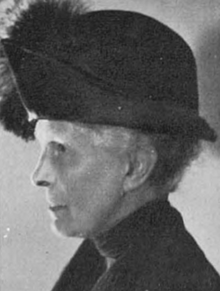Rose Champion de Crespigny
Rose Champion de Crespigny (born Annie Rose Charlotte Key; 9 November 1859 – 10 February 1935) was an English artist and author, who published many novels as "Mrs Philip Champion de Crespigny".
Rose Champion de Crespigny | |
|---|---|
 Rose Champion de Crespigny, artist and spiritualist. From “Is there a Scientific Basis for Spiritualism?” ‘The Sphere’. 27 August, 1927. | |
| Born | Annie Rose Charlotte Key 9 November 1859 |
| Died | 10 February 1935 (aged 75) |
| Nationality | British |
| Known for | Painting, Writing |
| Spouse(s) | Philip Augustus Champion de Crespigny
( m. after 1878) |
Rose was the daughter of Admiral Sir Astley Cooper Key (who later changed the surname to Cooper-Key) and his wife, Lady Charlotte Lavinia (née McNeil). She was born 9 November 1859 in Kensington, and she was baptised 15 December 1859 at St John's, Notting Hill.[1]
As an artist, her paintings tended toward landscape;[2] her writing, after early forays into genealogical and local history, soon settled into popular fiction. Her work was described in a contemporary review as having "a certain graceful facility".[3] She was a leading member of the Ridley Art Club, the Lyceum Club in Piccadilly, and of the British College of Psychic Science.[4]
Rose married Philip Augustus Champion de Crespigny (1850-1912), a Royal Navy officer and son of Sir Claude William Champion de Crespigny, 3rd Baronet, on 1 October 1878 in Westminster. They had four children, including Frederick Philip Champion de Crespigny (1884–1947), who inherited the baronetcy, as the 7th Baronet, the year before his death:[5]
Select bibliography
- Key to the Roll of the Huguenots Settled in the United Kingdom (1884)
- The Roll of the Highland Clans of Scotland (1889)
- The New Forest; its traditions, inhabitants and customs (1895)
- From Behind the Arras (1902)
- The Mischief of a Glove (1903)
- The Rose Brocade (1905)
- The Grey Domino (1906)
- The Spanish Prisoner (1907)
- My Cousin Cynthia, and Others (1908)
- The Coming of Aurora (1909)
- The Valley of Achor (1910)
- The Five of Spades (1912)
- The Mark (1912)
- Hester and I (1915)
- Stories of To-day and Yesterday (1917)
- The Moving Finger (1919)
- The Shears of Atropos (1919)
- The Villa on the Borderive Road (1919)
- The Witness in the Wood (1919)
- The Case of Mr. Fitzgordon (1919)
- The Voice (1919)
- The Mind of a Woman (1922)
- The Valley of Orchids (1923)
- Tangled Evidence (1924), basis of film Tangled Evidence in 1934
- The Missing Piece (1927)
- The Dark Sea (1927)
- Straws in the Wind (1928)
- The Eye of Nemesis (1931)
- Glimpses into Infinity (1931)
- A Case for the C.I.D. (1933)
- The Riddle of the Emeralds (1934)
- This World and Beyond (1934)[6]
References
- Annie Rose Charlotte Key; baptised 15 December 1859; born 9 November 1859 London, England, Church of England Births and Baptisms, 1813-1906
- Artists' Papers Register, Rose Champion De Crespigny
- The Spectator Review: The Rose Brocade 22 April (1905)
- ""Victoriennes and Modern Girls are "Sisters Under Their Skins"". The Daily Standard (Brisbane) (5334). Queensland, Australia. 22 October 1929. p. 2. Retrieved 25 September 2019 – via National Library of Australia.
- Genealogical and Heraldic Dictionary of the Peerage and Baronetage of the British Empire. Burke's Peerage Limited. 1914. p. 585. Retrieved 19 July 2017.
- Amazon Authors Page: Rose Champion de Crespigny